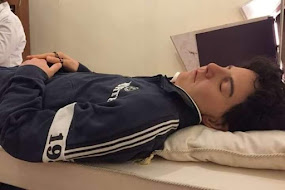BLESSED CARLO ACUTIS' BODY NOT INCORRUPT, BISHOP DOMENICO SORRENTINO CLARIFIES
Carlo Acutis was born in London on May 3, 1991, to Italian parents who moved the family to Milan when he was three months old. He attended local schools and then a Jesuit high school. Devoted to Our Lady from a young age, he made an effort to recite the Rosary daily. After his first Communion at age 7, he also strove to receive the Eucharist daily and weekly Confession.
Carlo was exceptionally compassionate and mature even as a child. When Bullies at school picked on classmates with disabilities, he stepped up to defend them. He also worried for friends who were suffering through their parents’ divorces, making a point of inviting them to his home and offering his support.
According to his mother, “Carlo led a normal life: He went to school, he played sports, he played video games, although usually just one hour a week because he understood that video games could enslave one.” She also admitted that her own son converted her. “Carlo was a very devout soul, even when he was very young. He loved to go to church, pray, and learn more about his faith. I was far from the Church; I grew up in a secular family, as millions of people do, I suppose. So, having this son who insistently asked me questions about the faith forced me to reflect. That was the reason why I drew closer to the Church.”
His school principal attests to his holiness: “He was a quiet child by nature, living in the context of a peaceful family. As time passed (also because the surname was recurrent in the media), I learned that his father, Andrea Acutis, was the manager of a large private company and that the family’s standard of living was quite high. But none of this stood out in Carlo or his parents. Today I often see spoiled and demanding children who are capricious with their parents, selfish with their classmates, and perhaps spoiled by excessive wellbeing. There was never any sign of this in Carlo: he was a child who integrated harmoniously in the classroom, docile, with whom the teacher was happy. His parents too were very polite and unpretentious, reserved people.”
An avid enthusiast of technology, Carlo was a gamer and a computer programmer. One of his most significant computer ventures was cataloging all the Eucharistic miracles of the world. He started the project when he was 11 years old and wrote at the time, “The more Eucharist we receive, the more we will become like Jesus, so that on this earth we will have a foretaste of Heaven.” He asked his parents to start taking him to all the places of the Eucharistic miracles. Two and half years later, the project was completed with his having researched over 130 Church-approved Eucharistic miracles occurring around the world. He collected these into a virtual museum and into panel presentations that have traveled around the globe.
In 2006, about one year after completing his Eucharistic Miracles project, Carlo died from leukemia after only a week of being diagnosed with the disease. He was only 15 years old at the time. The Medical Council of the Congregation for Saints’ Causes declared a positive opinion on an alleged miracle attributed to the intercession of Carlo: it concerned the the healing of a gravely ill boy in Brazil. This event paved the way for his beatification in 2020, making him the first “Millennial” to be named Blessed by the Church. As a young man who played video games, watched movies, and spent time with his friends, he is just one more proof that holiness is attainable for everyone.
It was widely reported—erroneously—that his body was found incorrupt at the time of its exhumation. While it was intact, it was not incorrupt. In photos released in preparation for his beatification, Carlo’s body appeared to be preserved from the natural decay process after his death in 2006, and some thought that he might be incorrupt. However, Bishop Domenico Sorrentino of Assisi clarified that Carlo’s body, though intact, “was found in the normal state of transformation typical of the cadaveric condition.” Bishop Sorrentino added that Carlo’s body was arranged with dignity for its display for public veneration and a silicone reconstruction of his face used. In other words, when one looks at the face of his major reliquary, it is not the actual skin and flesh one is seeing. Silicone, made to look in his likeness, covers his body.
His image—in jeans and sneakers—clashes with the traditional stained glass windows to which we are accustomed and shows that holiness is closer to us than we think.
Blessed Carlo Acutis, pray for us!




Post a Comment